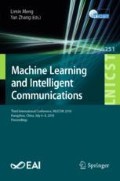Abstract
At present, the collection of environmental information is mostly accomplished by sensors. In order to reduce the redundancy of sensor data collection, reduce the energy consumption of nodes, improve the service life of sensors and reduce the cost of the system, a system that combines compressed sensing reconstruction with sensors is proposed in this paper to collect and reconstruct environmental information. The designed system collects the environment information with a limited number of nodes. Compressed sensing reconstructs all the data of the required area through the optimized OMP algorithm. The final information is displayed by the software based on C# designing. The final result shows that the verification system proposed in this paper can realize the accurate reconstruction of the original environmental information, and it is effective to the collection and processing of complex environmental information.
Access this chapter
Tax calculation will be finalised at checkout
Purchases are for personal use only
References
Donoho, D.L.: Compressive sensing. IEEE Trans. Inf. Theory 52(4), 1289–1306 (2006)
Baraniuk, R., Davenpo, M., DeVore, R.: A simple proof of the restricted isometry property for random matrices. Constr. Approx. 28(3), 253–263 (2007)
Tao, E., Near, T.: Optimal signal recovery from random projections: universal encoding strategies. IEEE Trans. Inf. Theory 52, 5406–5425 (2006)
Candes, E., Tao, T.: Decoding by liner programming. IEEE Trans. Inf. Theory 51(12), 4203–4215 (2005)
Chen, S., Saunders, M.: A atomic decomposition by basis pursuit. SIAM J. Sci. Compute. 33–61 (1998)
Ameha, T., Chung, G.K.: Compressive sensing-based random access with multiple-sequence spreading for MTC. In: 2015 IEEE Globecom Workshops (GC Wkshps), pp. 1–6. IEEE Press (2015)
Bockelmann, C., Schepker, H.F., Dekorsy, A.: Compressive sensing based multi-user detection for machine-to-machine communication. Trans. Emerg. Telecommun. Technol. 24, 389–400 (2013)
Cui, J.: The challenges of building scalable mobile underwater wireless sensor networks for aquatic applications. IEEE Netw. 20(3), 12–18 (2006)
Wang, W., Yang, W., Li, J.: An adaptive sampling method of compressed sensing based on texture feature. Optik-Int. J. Light Electron Opt. 127(2), 648–654 (2016)
Cao, C., Gao, X.: Compressed sensing image restoration based on data-driven multi-scale tight frame. J. Comput. Appl. Math. 309, 622–629 (2017)
Acknowledgments
This work is supported in part by National Natural Science Foundation of China (No. 61401118, No. 61371100 and No. 61671184), Natural Science Foundation of Shandong Province (No. ZR2018PF001 and ZR2014FP016), the Fundamental Research Funds for the Central Universities (No. HIT.NSRIF.2016100 and 201720) and the Scientific Research Foundation of Harbin Institute of Technology at Weihai (No. HIT(WH)201409 and No. HIT(WH)201410).
Author information
Authors and Affiliations
Corresponding author
Editor information
Editors and Affiliations
Rights and permissions
Copyright information
© 2018 ICST Institute for Computer Sciences, Social Informatics and Telecommunications Engineering
About this paper
Cite this paper
Zhao, Q., Li, B., Yang, H., Liu, G., Ma, R. (2018). Designing of Environmental Information Acquisition and Reconstruction System Based on Compressed Sensing. In: Meng, L., Zhang, Y. (eds) Machine Learning and Intelligent Communications. MLICOM 2018. Lecture Notes of the Institute for Computer Sciences, Social Informatics and Telecommunications Engineering, vol 251. Springer, Cham. https://doi.org/10.1007/978-3-030-00557-3_58
Download citation
DOI: https://doi.org/10.1007/978-3-030-00557-3_58
Published:
Publisher Name: Springer, Cham
Print ISBN: 978-3-030-00556-6
Online ISBN: 978-3-030-00557-3
eBook Packages: Computer ScienceComputer Science (R0)

